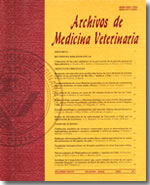Evaluation of the herbage allowance and type of concentrate on some ruminal parameters of grazing dairy cows during autumn
Main Article Content
Abstract
This study was undertaken to evaluate the influence of daily pasture allowance and concentrate type on ruminal pH, the ammonia nitrogen (N-NH3) and the volatile fatty acid (VFA) concentrations in the rumen of autumn-calving dairy cows in early lactation. Three Chilean Black Friesian cows fitted with ruminal cannulas where used. The four dietary treatments were a combination of two pasture allowances above ground level (moderate, 25.5 and high, 38.5 kg of dry matter/cow/day) and two concentrate types offered at the level of 5 kg/cow/day, corn-based concentrate (A) and sugar beet pulp-based concentrate (F). After an adaptation period of nine days, liquor rumen samples were taken and pH was measured immediately. The remaining samples were preserved for ammonia and VFA analyses. Statistical analysis was carried out through a linear mixed model using a factorial design of repeated measures. pH levels were not affected by pasture allowance (P > 0.05), whereas the effect of type of concentrate was affected (P < 0.05). The averages were 6.19 and 6.07 for corn-based concentrate and sugar beet pulp-based concentrate, respectively. Pasture allowance affected (P < 0.05) rumen ammonia concentration (9.7 and 18.2 mmol/L, for high and moderate pasture allowances, respectively) and the total VFA (43.6 and 67.4 mmol/L, for high and moderate pasture allowances, respectively). The effect of type of concentrate did not affect N-NH3concentration (P > 0.05). It can be concluded that offering a high pasture allowance to dairy cows would synchronize more efficiently ruminal fermentation. The supplementation with moderate amount of concentrate maintains pH under physiological range, even though beet pulp based concentrates produce a greater amount of ruminant VFA.

